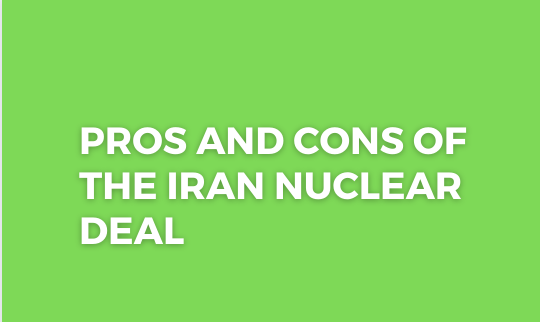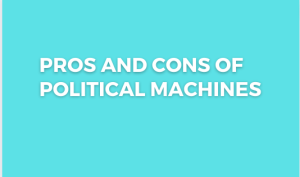The Iran nuclear deal, officially known as the Joint Comprehensive Plan of Action (JCPOA), was an agreement reached in 2015 between Iran and six world powers aimed at limiting Iran’s nuclear program. Here are 40 pros and cons of the Iran nuclear deal.
Pros:
- Nuclear restrictions: The deal imposed strict limits on Iran’s nuclear program, including reducing its uranium enrichment levels and stockpiles.
- Verification mechanisms: Robust monitoring and inspection measures were implemented to ensure Iran’s compliance with the deal.
- Delayed nuclear breakout: The restrictions and monitoring measures significantly delayed Iran’s ability to develop nuclear weapons.
- Diplomatic solution: The agreement provided a diplomatic framework to address Iran’s nuclear ambitions and prevent military conflict.
- Regional stability: The deal aimed to enhance stability in the Middle East by reducing the risk of nuclear proliferation.
- Economic benefits for Iran: The lifting of economic sanctions under the deal provided Iran with access to international markets and increased trade opportunities.
- Increased transparency: Iran was required to provide detailed information about its nuclear program, increasing transparency and reducing uncertainties.
- Improved relations: The deal offered a potential path to improved relations between Iran and the international community.
- Non-proliferation commitment: The agreement reinforced the commitment to non-proliferation and set a precedent for future nuclear negotiations.
- Positive impact on global security: The deal reduced the likelihood of nuclear proliferation, thereby enhancing global security.
- Cooperation on other issues: The JCPOA created an opportunity for Iran and the international community to cooperate on other regional and global challenges.
- Humanitarian benefits: The deal facilitated the import of humanitarian goods and medical supplies to Iran, benefiting the Iranian population.
- Enhanced IAEA access: The International Atomic Energy Agency (IAEA) gained expanded access to Iran’s nuclear facilities and information.
- Prevented an arms race: The agreement prevented a potential arms race in the Middle East by curtailing Iran’s nuclear program.
- Confidence-building measures: The JCPOA included measures to build trust and confidence between Iran and the international community.
- Multilateral cooperation: The negotiation and implementation of the deal demonstrated successful multilateral cooperation and diplomacy.
- Reduced tensions: The agreement helped reduce tensions between Iran and the United States, easing geopolitical strains.
- Preserved Iran’s civilian nuclear program: The deal recognized Iran’s right to develop a peaceful civilian nuclear program while placing restrictions on its military dimensions.
- Economic benefits for other countries: The lifting of sanctions allowed other countries to engage in trade and investment with Iran, benefiting their economies.
- Prevented military intervention: The agreement provided a peaceful resolution to the Iranian nuclear issue and avoided the need for military intervention.
Cons:
- Insufficient constraints: Critics argue that the deal did not impose enough restrictions on Iran’s nuclear program to prevent its long-term development.
- Limited duration: The time-limited nature of some restrictions raised concerns about Iran’s nuclear ambitions after certain provisions expire.
- Verification challenges: Some critics believe that the inspection mechanisms were insufficient to detect potential covert nuclear activities.
- Sanctions relief: Critics argue that the lifting of sanctions provided Iran with significant economic benefits without ensuring a change in its behavior.
- Regional instability: Critics claim that the deal emboldened Iran and destabilized the region by strengthening its influence and support for proxies.
- Noncompliance concerns: There were concerns about Iran’s compliance with the deal, particularly regarding its commitment to transparency and disclosure.
- Ambiguous language: Critics argue that the deal contained ambiguous language that allowed for different interpretations, potentially undermining its effectiveness.
- Failure to address non-nuclear issues: Critics contend that the deal did not address Iran’s support for terrorism, human rights violations, or ballistic missile development.
- Lack of consensus: The agreement faced opposition from some countries, undermining its universal acceptance and long-term viability.
- Danger of nuclear breakout: Critics warned that the deal only delayed Iran’s nuclear ambitions and did not eliminate the risk of it eventually acquiring nuclear weapons.
- Escalation risks: The deal’s opponents believed that it could escalate tensions in the region, as it did not address Iran’s regional activities.
- Erosion of trust: The deal created divisions among the signatories and eroded trust between Iran and some Western countries.
- Limited role for regional actors: Critics argued that regional actors, particularly Iran’s neighbors, should have had a more significant role in the negotiations and implementation of the deal.
- Missed opportunities for broader negotiations: Some critics believed that the deal missed an opportunity to address other regional issues beyond Iran’s nuclear program.
- Negative impact on nonproliferation norms: Critics contended that the deal weakened nonproliferation norms by rewarding Iran’s noncompliance in the past.
- Escalation of proxy conflicts: The deal’s opponents warned that the influx of economic benefits to Iran could contribute to its support for regional proxies, exacerbating conflicts.
- Flawed dispute resolution mechanisms: Critics argued that the dispute resolution mechanisms outlined in the agreement were insufficient to address violations effectively.
- Incomplete dismantling of infrastructure: Critics claimed that the deal did not require Iran to completely dismantle its nuclear infrastructure, leaving open the possibility of a future breakout.
- Increased leverage for Iran: The deal’s opponents believed that the economic benefits and sanctions relief provided Iran with increased leverage in its regional and international relations.
- Perception of unequal treatment: Critics argued that the deal treated Iran more favorably than other countries with nuclear ambitions, creating a perception of unequal treatment in the international community.
Pros
- Nuclear restrictions
- Verification mechanisms
- Delayed nuclear breakout
- Diplomatic solution
- Regional stability
- Economic benefits for Iran
- Increased transparency
- Improved relations
- Non-proliferation commitment
- Non-proliferation commitment
- Cooperation on other issues
- Humanitarian benefits
- Enhanced IAEA access
- Prevented an arms race
- Confidence-building measures
- Multilateral cooperation
- Reduced tensions
- Preserved Iran’s civilian nuclear program
- Economic benefits for other countries
- Prevented military intervention
Cons
- Insufficient constraints
- Limited duration
- Verification challenges
- Sanctions relief
- Regional instability
- Noncompliance concerns
- Ambiguous language
- Failure to address non-nuclear issues
- Lack of consensus
- Danger of nuclear breakout
- Escalation risks
- Erosion of trust
- Limited role for regional actors
- Limited role for regional actors
- Limited role for regional actors
- Escalation of proxy conflicts
- Escalation of proxy conflicts
- Escalation of proxy conflicts
- Increased leverage for Iran
- Perception of unequal treatment



